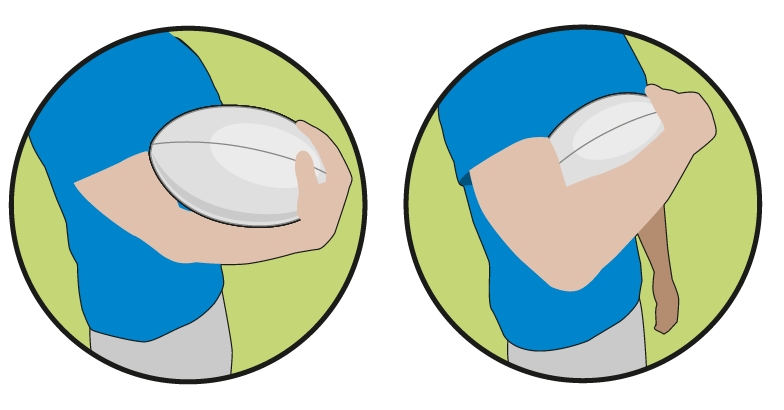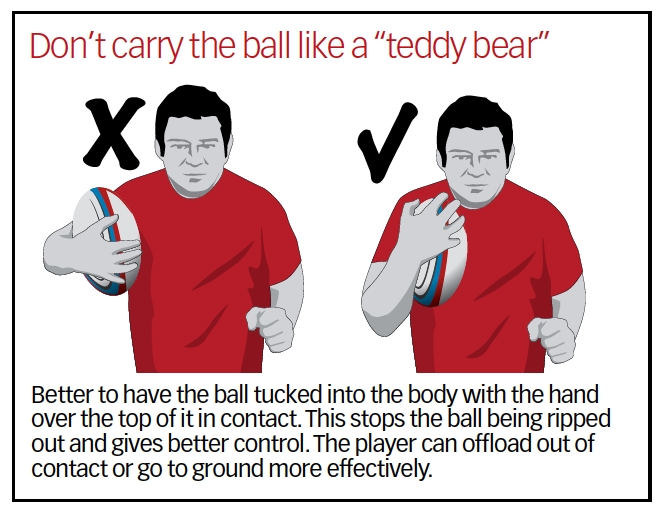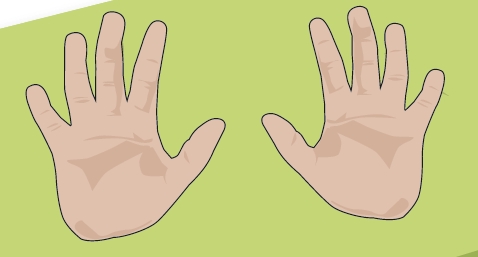Get to grips with the ball
The better your players can carry the ball, the more chance they’ll be able to retain it in contact or pass it under pressure. So help them improve their holding and handling skills with these five top tips…

Carry the ball in two hands and you will give yourself passing options, plus it’s easier to manipulate the ball just before contact.
But to have even better control, players should use all their fingers to grip the ball, hence 10 points of contact. The fingers should be spread and comfortable on the ball. When the player comes to adjust his hands to pass, the extra points of contact will help the player feel what’s right.
Another upside of the 10 points of contact is that players take the ball off their chest. That helps with passing. If they come close to contact, they can pull the ball into their body.
Carrying the ball in one hand helps the player run faster and enables him to keep it away from opponents approaching from one side.
Now the ball carrier concentrates on four points of contact – the hand, forearm, bicep and chest. He should be able to bring the ball away from the body to offload on either side.

The elbows play a big part in the grip. When a player carries the ball away from the body, his elbows are away from the body. Just before contact, his elbows bring the ball tight into the body.
Practise by having a ball carrier and support player walk towards two ruck-pad holders. The carrier keeps the ball away from his body. He either passes before contact or takes contact, adjusting his elbows as necessary. The players should practise manipulating the ball to help them use the right grip for contact.
Get players to carry the ball in front of the body, not out to the side. If a player carries the ball as he would a teddy bear – that is, tucked under his arm and into the side of the body – it’s more difficult to manipulate the ball. It’s also easier to rip the ball away from the carrier.


The grip starts with the catch. Young players catch the ball in a variety of ways, though the preferred way is to use the “W” shape.

Catching games are good for awareness, especially for beginners getting used to the odd shape and unpredictability of a rugby ball. But the more game-related that games are the better, with players working on taking a pass when they’re moving forward and the ball is coming from the side.
Work your players on their grip under pressure with:
1 TEN POINTS OF CONTACT

Carry the ball in two hands and you will give yourself passing options, plus it’s easier to manipulate the ball just before contact.
But to have even better control, players should use all their fingers to grip the ball, hence 10 points of contact. The fingers should be spread and comfortable on the ball. When the player comes to adjust his hands to pass, the extra points of contact will help the player feel what’s right.
Another upside of the 10 points of contact is that players take the ball off their chest. That helps with passing. If they come close to contact, they can pull the ball into their body.
2 FOUR POINTS OF CONTACT
Carrying the ball in one hand helps the player run faster and enables him to keep it away from opponents approaching from one side.
Now the ball carrier concentrates on four points of contact – the hand, forearm, bicep and chest. He should be able to bring the ball away from the body to offload on either side.

3 ELBOWS AND BODY
The elbows play a big part in the grip. When a player carries the ball away from the body, his elbows are away from the body. Just before contact, his elbows bring the ball tight into the body.
Practise by having a ball carrier and support player walk towards two ruck-pad holders. The carrier keeps the ball away from his body. He either passes before contact or takes contact, adjusting his elbows as necessary. The players should practise manipulating the ball to help them use the right grip for contact.
4 AVOID THE "TEDDY BEAR"
Get players to carry the ball in front of the body, not out to the side. If a player carries the ball as he would a teddy bear – that is, tucked under his arm and into the side of the body – it’s more difficult to manipulate the ball. It’s also easier to rip the ball away from the carrier.

5 PRECISION IN THE CATCH

The grip starts with the catch. Young players catch the ball in a variety of ways, though the preferred way is to use the “W” shape.

Catching games are good for awareness, especially for beginners getting used to the odd shape and unpredictability of a rugby ball. But the more game-related that games are the better, with players working on taking a pass when they’re moving forward and the ball is coming from the side.
Work your players on their grip under pressure with:
Related Files
Vol-2-Issue-061-RCW-get-to-grips-with-the-ball.pdfPDF, 271 KB
Newsletter Sign Up
Coaches Testimonials

Gerald Kearney, Downtown Las Vegas Soccer Club

Paul Butler, Florida, USA

Rick Shields, Springboro, USA

Tony Green, Pierrefonds Titans, Quebec, Canada
Subscribe Today
Be a more effective, more successful rugby coach
In a recent survey 89% of subscribers said Rugby Coach Weekly makes them more confident, 91% said Rugby Coach Weekly makes them a more effective coach and 93% said Rugby Coach Weekly makes them more inspired.
Get Weekly Inspiration
All the latest techniques and approaches
Rugby Coach Weekly offers proven and easy to use rugby drills, coaching sessions, practice plans, small-sided games, warm-ups, training tips and advice.
We've been at the cutting edge of rugby coaching since we launched in 2005, creating resources for the grassroots youth coach, following best practice from around the world and insights from the professional game.














